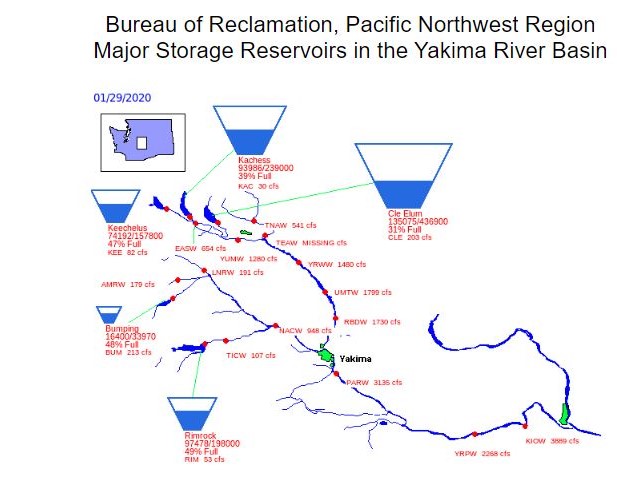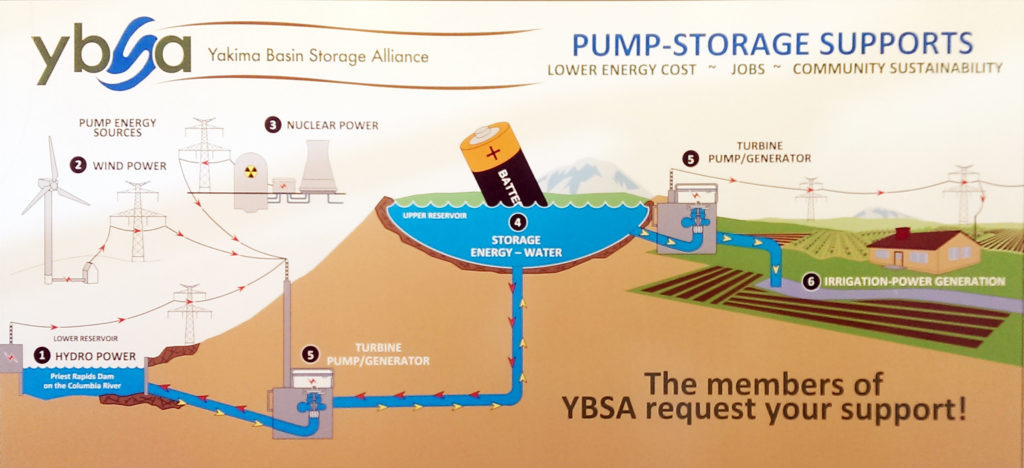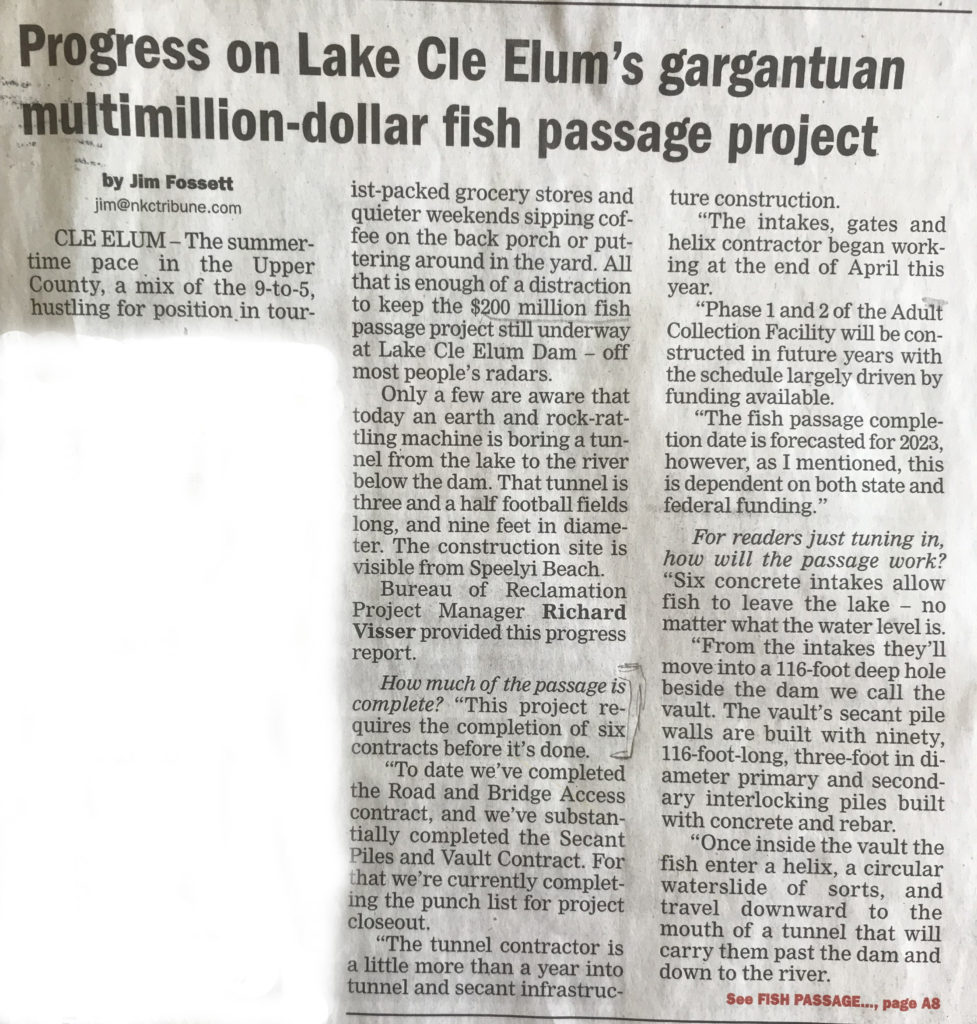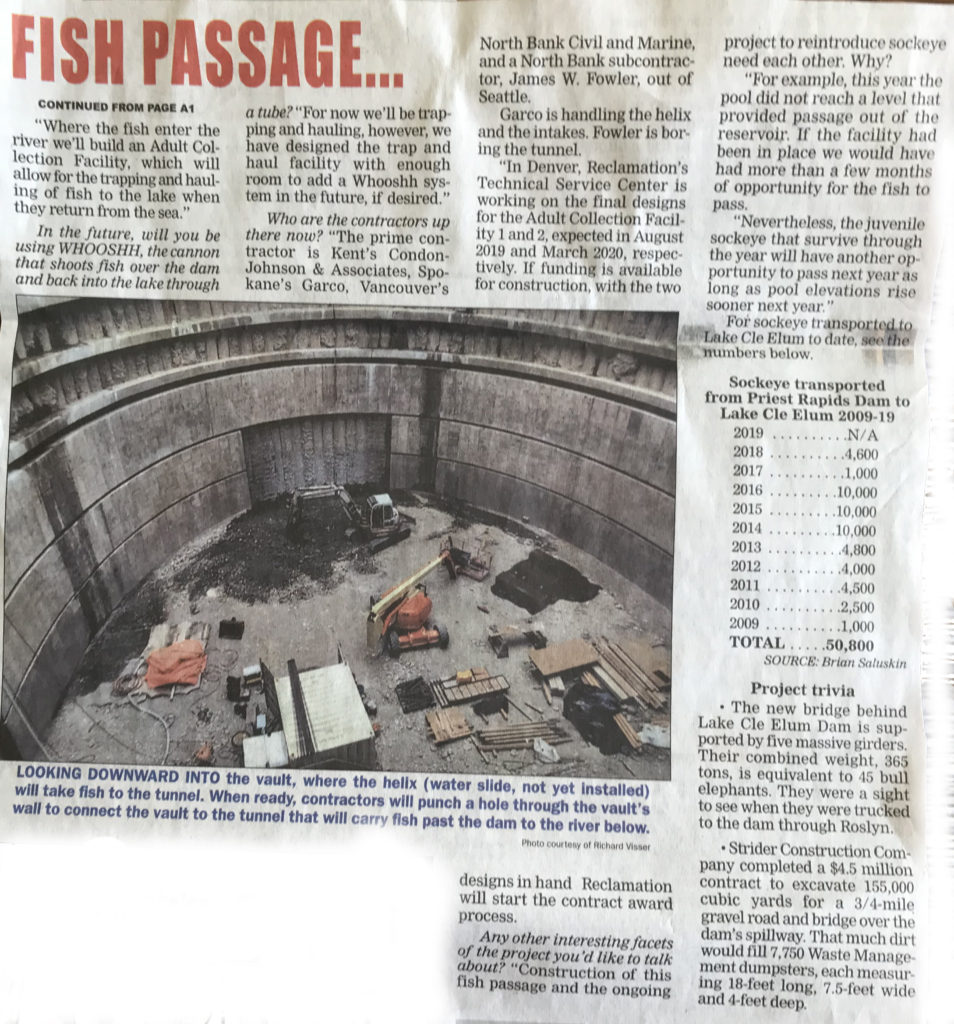YBSA Monthly Report January 2020
Stored Water: Storage in the 5 reservoirs is at 39% of capacity which is 100,000 acre/feet less than average.

Snow water equivalent in the upper Yakima Basin is at 82% of average and in the lower Yakima Basin is at 105% of average. Snowpack is responsible for 2/3 of the water necessary for both instream flow for fish and out of stream use for agriculture. The only source of water that will prevent droughts, which effect the economy in the Yakima Basin, is water from the Columbia River.
Projects in the Yakima Basin Fish Passage:
Cle Elum Dam Fish Passage Facilities and Reintroduction Project – The juvenile fish passage facility will use an innovative helix design to transport juvenile fish downstream. The upstream adult fish passage facility will be a trap-and-haul facility where fish are trapped at the base of the spillway, loaded into a truck, and then hauled for release into Cle Elum Reservoir or to upstream tributaries.
Box Canyon Creek Fish Passage – A completed conceptual design for the Box Canyon Creek Fish Passage Enhancement Project has been completed. The final design work is expected to begin following discussions with potential project partners.
Clear Creek Dam Fish Passage – The Bureau of Reclamation completed an appraisal level design for fish passage.
Projects in the Yakima Basin Structural and Operational Changes Element:
Cle Elum Pool Raise – The purpose of the Cle Elum Pool Raise Project is to increase the reservoir’s capacity for improved aquatic resources for fish habitat, rearing, and migration in the Cle Elum and upper Yakima Rivers.
Lower Yakima River Smolt Survival Study – The lower Yakima River smolt survival study was initiated in 2018. The study continues today.
Projects in the Yakima Basin Surface Water Storage Element:
Kachess Drought Relief Pumping Plant (KDRPP) – The Bureau of Reclamation signed the Record of Decision (ROD) which does not approve implementation of the Keechelus to Kachess Pipeline. The Environmental Impact Statement for the Kachess floating plan will continue.
Wymer Reservoir – Consideration of site requirements is ongoing.
Bumping Reservoir Enlargement Project – Consideration of site requirements is ongoing.
Projects in the Yakima Basin Groundwater Storage Element:
Groundwater Storage – Basin wide analysis is continuing.
Projects in the Yakima Basin Conclusion: Projects continue to address habitat and fish passage. These projects can only be successful when there is an annual supply of water. The Kachess Drought Pumping Plan would not meet the goal of more than 500,000 acre/feet that is needed annually. If it doesn’t fill, how will the available water be distributed, instream or out of stream use? Fish returning up the Yakima River have not increased. Fish numbers cannot increase without a more consistent flow of water.
YBSA Monthly Report December 2019
Merry Christmas and a Happy and Prosperous New Year!
Storage Water: Water stored in all five reservoirs at this time is at 26% of average or 170,000 less then normal. Lake Cle Elum, our largest reservoir, is at 18% of average. Snow water equivalent in the upper basin is at 39% and the lower basin is at 58%. A big snow event in February like last year could prevent a drought in the summer and fall of 2020.
Lake Kachess Pumping Project: The Bureau of Reclamation has promised a record of decision on the Lake Kachess Pumping Project but is now waiting for the Roza Irrigation District to make a statement on the project. The Bureau of Reclamation is required by law to determine what needs to be addressed environmentally and what must be accomplished.
Yakama Nation: Congratulations to the Yakama Nation on the successful completion of the Coho Salmon Hatchery near Ellensburg. Additionally, the Confederated Tribes and Bands of the Yakama Nation has received $414,000 of state grant money for habitat restoration projects to aid with recovery efforts for Steelhead Trout. The funds were awarded to the Yakama Nation for three habitat restoration projects along Ahtanum Creek and the Tieton and Klickitat Rivers to help improve conditions for the area’s steelhead trough populations, a threatened species under the Endangered Species Act.
Currently and for the last few years the ability for salmonoids returning up the Yakima River has not increased to what the Yakima Basin Integrated Plan was adopted to generate. Because the instream flow in the Yakima River has been so low some salmonoids are threatened species. If all interested parties were working together with the Yakama Nation to improve the volume of water for the Yakima River Basin we could eliminate our annual question: Is there enough water?.
Columbia River Water: If Columbia River water was made available to irrigate the Sunnyside and Roza Irrigation Districts, water would be available for instream flow. Successfully transferring water from the Columbia River to the Yakima River Basin would address the annual concerns for drought which effects the economy and lifestyle in the Yakima Basin.
Future for the Integrated Plan: A draft developed by the Bureau of Reclamation includes projects extending through 2030 and beyond. The estimated cost of $750 million includes many projects that would address the needs in the Yakima Basin. There is no plan to increase the water available for instream flow (fish) or out of stream usage (agriculture). The Yakima Basin Integrated Plan goal was to provide approximately 500,000 acre/feet of water. The draft plan does not indicate that after spending billions of dollars the goal would not be met after 20 years. Adding the use of the Columbia River water would solve the problem.
YBSA Monthly Report November 2019
YBSA Monthly Report
November 2019
Storage Capacity: Storage is at 20% of average1 150,000 acre/feet less than normal. Lake Cle Elum, the largest reservoir, is at 14%. Total storage is at 58% of average.
Lower Yakima River: Flows have been very low since this summer. The Yakima River channel has decreased with grasses growing in parts of the riverbed. Fish survival and passage has been minimal.
Climate Change: Weather patterns have changed with storm tracks moving through Canada. Snowpack is crucial for the Yakima Basin. It provides 2/3 of the water necessary for instream flow and out-of-stream use.
Kachess Drawdown Project: The decision to move forward depends on the Record of Decision to be issued by the Bureau of Reclamation. It has been 4 years since the Environmental Impact Statement was published. Why is the Bureau of Reclamation still waiting to make a decision? Delaying the decision won’t make the Kachess Project a better project. No decision can be made to access additional water until the decision by the Bureau of Reclamation is made. When there is insufficient water in Kachess Reservoir will fish and/or agriculture share that water.
Pump Storage: A pump storage project, using Columbia River water, would benefit the Yakima Basin and its water needs. Pump storage projects are operated with multiple beneficial results. See the diagram below to see the many uses.

The benefits to the Yakima River Basin would be
• water for fish year-round, water for irrigation during drought years
• surface water uses to reduce ground water pumping
• power generation to supplement the electrical grid
• increase salmonoid population to the Columbia River
• a reservoir for recreational use
YBSA Monthly Report October 2019
YBSA Monthly Report
October 2019
Storage Capacity: With the end of the irrigation season the remaining water is at 17% of capacity which is 100,000 acre/feet below average. The remaining water in the reservoirs is to be carried over for the 2020 season. The largest reservoir, Lake Cle Elum, is at 12%. At the start of irrigation season last year Lake Kachess was not filled to capacity. With the possibility of a small snowpack this winter and of less water available in storage, irrigators and fish will be affected next year. At present the water released from the reservoirs is 1/3 of what is flowing into the reservoirs.
Record of Decision: The Environmental Impact Statement that was prepared for the drawdown of Lake Kachess is still being reviewed by the Bureau of Reclamation. Once the Record of Decision is released the mitigation requirements have to be accomplish. Then a decision of how much Roza Irrigators will have to pay for implementation the project and the annual cost of maintenance and operation must be reached.
A working draft prepared by the Bureau of Reclamation, the Department of Ecology, and the Yakama Nation drafted March 22nd, 2019 is an outline of how to plan for additional projects implantation in the Yakima Basin. No mention of how to proceed with acquisition of the water needed for-out-of stream and instream uses. The use of Columbia River water is the best solution.
YBSA Monthly Report September 2019
YBSA Monthly Report
September 2019
Storage Capacity: Capacity of water storage in the Yakima River Basin’s 5 reservoirs is 16% of capacity. The amount of water remaining in the reservoirs will be way below the normal carryover for the 2020 irrigation season. Carryover water that remained in October 2018 was 290,000 acre/feet and currently at the end of the 2019 irrigation season only 174,000 acre/feet remaining. Weather patterns have changed and available snowpack which provides 2/3 of the water for instream flow, fish, and out-of-stream use for agriculture. The water supply in the summer of 2019 was adequate. The agricultural community was able to make adjustments, but the lower Yakima River was green with algae and too warm for fish.
End of Irrigation Season: The Sunnyside Valley Irrigation District will begin shutting down on October 18th and Roza water delivery will be curtailed on October 1st, 2019.
Additional Storage for the Yakima Basin: 10 years have passed since the Yakima Basin Integrated Plan was adopted and no additional storage has been made available. The Lake Kachess drought relief plan is still being reviewed and the Record of Decision (ROD) will be available soon. Lake Kachess did not fill completely in 2019. The fish passage project at Lake Cle Elum Dam is progressing with a small amount of water being available for instream flow and fish passage.
The Integrated Plan originally included Columbia River water for the Yakima Basin. The Integrated Plan Workgroup was to consider Columbia River water use if all the possible storage opportunities in the basin would not reach 450,000 acre/feet of water. The projects currently under review will not provide the water needed during drought conditions.
It is time for a review of the use of Columbia River water for irrigation and consequently we would have more instream flow for fish!
The Umatilla area farmland use of Columbia River water is progressing.
$1Billion Montana Pumped Storage Hydro Project Secures Funding: Click Here for Article.
YBSA Monthly Report August 2019
August 2019
Storage Capacity: In the Yakima Basin reservoirs storage is at 30% with inflow at 604 cubic feet per second (cfs) and released at 4191 cfs. Junior water right holders are currently receiving 69% supply. Currently the reservoir capacity is 180,000 acre/feet less than average.
Annual Flip Flop: Every year to protect spawning grounds in the upper Yakima River flow of water is reduced. The reduced flow is put in place to force the fish to spawn near the center of the river. Then the water stored in the reservoirs in the Naches River Basin is released to nearly flood stage to counteract the reduced flow from the upper Yakima River. See this article from the Yakima Herald Republic September 1st, 2019.
Carryover: Annual carryover of stored water may be at a minimum at the end of the irrigation season. Snowpack this winter will determine the water available for instream flow and out of stream use (fish & agriculture). The Farmer’s Almanac is predicting snow events this winter.
Climate Change: With conservation measurers in place the out of stream water for agriculture has been enough for a good year for agriculture. In stream flow is dangerously low especially in the lower Yakima River. Currently the warm water, covered in many places with green algae, is
hazardous to fish. The Lake Cle Elum fish passage project continues. Completion is about 2 to 3 years away. More water in the Yakima River will be needed to make the project successful. The mighty Columbia River continues to flow above average and fishing has been opened.
Go to www.ybsa.org for additional information.
YBSA Monthly Report July 2019
YBSA Monthly Report
July 2019
Water Available: At the end of July, the five Yakima Basin reservoirs register at 53% which is 200,000 acre/feet less than average. There is 988 cfs entering the 5 reservoirs at this time with 5277 cfs released. With a decline of total water supply junior users are currently receiving a 67% supply
Lake Cle Elum Fish Project: Construction of the fish passage project is estimated to be in future years when funding becomes available. When the lake reaches the level sufficient for fish passage out of the reservoir. If the Lake level does not exceed 2019 the fish will not be able to move from the lake to the river.
Article from Northern Kittitas County Tribune Thursday, July 18, 2019.


Three Rivers Pump Hydro Storage Workshop: A long term need for base loaded power is larger than widely known. 8.000 MW may be short by 2030. Batteries can provide the same storage for a short duration at 6 times more carbon footprint than Pump Hydro Storage.
Closed circuit pump hydro storage systems are not a good type project for long term success. Remitting has become easier to Pump Hydro Storage project since two new federal laws become effect in the drought of 2014.
Full Meeting Notes Follow:
Three Rivers Pump Hydro Storage Workshop
Meeting Notes – June 24, 2019
Wrap-Up Summary of Take Away Key points:
Economics & Finance
Long term need for base load power is larger than widely known, from 3 sources:
2,250 MW shor by 2022
5,000 MW short by 2025 by 2030
8,000 MW short by 2030 (Source: E3 Consulting report)
Funding is available for PHS projects right now. $100M to $300M is typical.
Organization structure does matter. The limitation for irrigation districts to enter PPP arrangements has been removed.
Limiting factors ahead include pricing trends. For example, 6 weeks ago $1,200 per MWh compared to natural gas pricing $12 to $80 range.
Capacity issue caused a rate spike within Grant PUD to $5,000 per MWh.
City of Quincy will be out of power in 2022 due to new data centers to date.
California load ramps will be in the range of 15,000 MWh ahead (15 times City of Seattle needs).
Batteries can provide the same storage for short durations at six times the carbon footprint compared to PHS, although none are proven yet for 5 days of storage needed at grid scale when extended periods of low pressure eliminate solar and wind.
Environmental Permitting
Requires time, money and land.
2 of 3 FERC Permitting paths are best aligned with PHS proposals.
Now 7 PHS proposals activate is a 50% increased compared to 2014 so interest in PHS is trending upward.
Closed loop systems are low hanging fruit as a project type for permitting success.
Success in permitting starts with communication and permitting is becoming easier (2 new federal laws in August 2014 streamlining less than 10 MW hydro, FERC rule changes, BPA reg practice changes).
Transmission
100% clean energy in WA state is a major challenge ahead. The cost to go from 98% to 100% clean will increase 10 times current rates.
PHS could be load or generator or interconnect or live load, depending on the business model as presented to BPA Transmission at the time of approval.
Defined terms for BPA for PHS create 3 categories of PHS proposals:
- Large
- Small
- Line & load interconnections
BPA Transmission policy and procedure operated on a philosophy of “show me the money” requiring applicant funded deposits upfront ranging from $120,000 for less than 20 MW proposals and approximately $200,000 for other projects for required BPA reviews and studies.
YBSA Monthly Report June 2019
Water Availability: Ecology forecasts the total natural water supply available to the Yakima’s three watershed comprising 6,150 square miles will be 75 percent of normal, May to September. Hence drought was declared in the Upper Yakima, Lower Yakima and Naches watersheds this spring.
This also means some irrigators will receive a smaller ration of water, and others will be shut off. Irrigation supports a $4.5 billion agricultural economy in the Yakima Basin, where the U.S. Bureau of Reclamation manages five reservoirs to deliver water to irrigate 464,000 acres of farmland and to release water in pulses to support salmon. For additional information on how the drought affects the Yakima Basin Click Here from the Yakima Herald Republic.
Cle Elum Dam Fish Project: An innovative first of its kind multimillion-dollar project to move salmonoids from Lake Cle Elum back to the Yakima River is progressing toward completion. The increase in the capacity of the lake will provide additional water for the fish to navigate the Helix and provide more water in the river for fish to return. For more information Click Here from the Yakima Herald Republic.
Pump Storage Workshop: On June 24th TRIDEC (Tri-Cities Economic Development Association), YCDA (Yakima County Economic Association), and YBSA (Yakima Basin Storage Alliance) hosted a workshop in the Walter Clone Center in Prosser. The value of pump storage project: the benefits of power generation, fish and agriculture were covered.
Yakima Basin Funding Update: $40 million for Yakima Basin Integrated Plan mostly for fish enhancement and $4.2 million for Yakima River improvements have been appropriated.
Go to www.ybsa.org for additional information.
YBSA Monthly Report May 2019
Water Available: The water in the 5 reservoirs in the Yakima Basin is at 80% of capacity. The smaller snowpack is being reduced by the very hot temperatures creating another water short year.
Final Water Report: The Bureau of Reclamation will publish their final water report soon. It will include an estimate on the amount of water for the irrigation districts in the Yakima Basin.
Letter to the Editor by Charles Klarich, 80-year resident of the Yakima Basin: Water for the Yakima Basin
With the adjudication of water rights in the Yakima Basin completed, it’s time to locate the water needed to fulfill those rights.
The current snowpack in the Basin is at 50% of normal. The 5 reservoirs are 75% full, so proratable water users could get 75% or less water than needed. Instream flow in the lower river continues to create a thermal barrier for fish passage and survival. Is there a solution?
The only plan being considered is the floating pump project on Lake Kachess. These 200,000 acre/feet of water would come from 80 feet below the normal water surface and would only be used during drought years. With climate change it is possible Lake Kachess would not refill every year after drought pumping. The cost of the floating pumping plant, which will remain on the lake, is estimated to be more than $252 million. Annual costs for maintenance and mitigation will be added. It is anticipated the Roza Irrigation District would pay for the project.
The Yakima River Basin Integrated Plan does not provide the water needed. Roll on Mighty Columbia Roll on . . . send some water to the Yakima Basin!
Yakima River Basin Integrated Water Resource Management Plan: May 2019
• Lake Cle Elum fish passage over the dam to provide for the downstream passage for fish returning to the Cle Elum River is progressing.
• Box Canyon Creek and Clear Creek Dam are being evaluated for fish passage.
• Lower Yakima River Study – Study to identify salmon and steelhead behavior in the lower river during spring and summer months based on instream flow.
• Lake Kachess Pumping Project Environmental Impact Statement has been issued and is being reviewed.
• Wymer and Bumping Lake Reservoirs are ongoing.
Go to www.ybsa.org for additional information.
YBSA Monthly Report, April 2019
YBSA Monthly Report
April 2019
Water Availability: As of April 28th, the reservoirs are at 63% capacity and at 87% of average. Lake Kachess is at 78% of capacity. The NRCS reports the snow water equivalent for the upper Yakima Basin at 61% of average and the lower Yakima Basin sites at 85% of average.
Lake Kachess Pumping Plant: The Bureau of Reclamation completed the Kachess EIS and determined the floating pump project could move forward. There will be a year long review period for additional comments. Financing for the project is still being considered and the Roza Irrigation District is considering paying for the pumping project. As of now no other monies are available for mitigation.
The First DEIS of the Lake Kachess Project: The plan was to pump 200,000 acre/feet of water, 80 feet from dead storage below the dam. It also included a project to transfer water from Lake Keechelus to Lake Kachess. The DEIS stated that the water would not be available every year. In Chapter 4, Section 4.3 Surface Water Resources, it states that after using the dead water from Lake Kachess it would take 2-5 years to refill. The first draft of the EIS was continued. The updated Lake Kachess Environmental Impact document has been completed and publicized.
Yakima Basin Integrated Plan Report:
• Continue working on project to provide fish passage over Lake Cle Elum Dam.
• Designing and implementing improvements to rivers and streams in the upper basin for fish passage.
• Locating areas of cool water in the lower Yakima River to help salmon and steelhead survive during the hot summer months.
• Evaluate possibilities of providing greater flow and cooler water in the lower Yakima River.
• Receive approval of some funding from the Federal Government to continue to move forward on the Integrated Plan.
Report to the Integrated Plan Workgroup: A pipeline complex in the Umatilla Basin would bring Columbia River water to farmland. The Umatilla project would provide water for 3 different areas in the Umatilla Basin. The 3 pipelines each 6½ feet in diameter will transfer water from the Columbia River to the farms. Part of the mitigation would eliminate the need to continue pumping groundwater. Groundwater retention could provide additional water for the Umatilla River. 40 years ago, a Columbia River pumping project provided water for farms and instream flow. This new project would provide instream flow to enhance the population of salmonids in the Umatilla River. The first phase of the Columbia River water project for the Umatilla Basin farms will begin in 2019. Secured bank financing will enable the project to go online in 2020.
The Yakima River Basin Workplan includes a review of the use of Columbia River water for the Yakima Basin. Ten years have passed, and the Yakima Integrated Plan Work Group has not considered how the transfer and storage of Columbia River water would address all the needs for agriculture, fish and the economy.
The question is why have other regions been able to benefit from the Columbia River but not the
Yakima Basin? It’s time to move forward toward solving the Yakima Basin’s water problem for the next century.